 |
| Chitapampa. photo by Claudia Paya |
Our group has shrunk to seven women. While everyone else split off to go see Machu Picchu, those of us that remain--Rosa, her daughter Claudia, Dr. Teresa from Alaska, Michelle who will connect with the women in Rosa's textile project to sell their items in the states, Marie who keeps us all laughing, Alice who is blonder than I but who was born and raised in Peru, and me!--went out in a van to visit the startup textile factory Rosa has been working hard to create in the village of Chitapampa. The village is about half an hour from Cusco into the Sacred Valley.
We arrived in a cloud of dust and were led immediately by Rosa's Peruvian friend Percy into the room where four recently purchased (by Rosa) knitting machines stood lined against one side. Pink
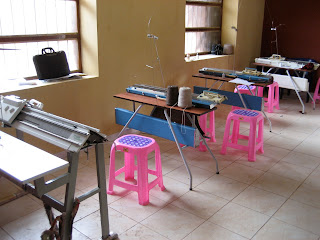 |
| Knitting machines in the "factory." photo by JG |
plastic stools stood at each work station and a length of half-finished sweater material was stretched on one of the machines. A mamita who had seen our arrival and welcomed us through the door turned on a loudspeaker in the corner and commenced a lengthy announcement in Quechua. I only understood one word in Spanish that was projected throughout the village--"apurensen"--hurry up everyone! Within a matter of moments the small room was filled with women, children, infants, men and even the village dogs . . . all coming to check out what was happening in the community room and to say hello to Rosa, their benefactor.
 |
| A collective effort. photo by JG |
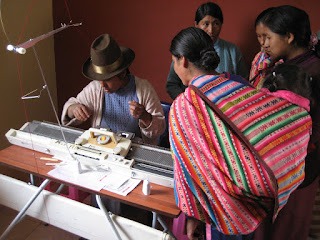 |
| photo by JG |
The pink stools were immediately occupied as groups of 3 or 4 women sat at the knitting machines with babies hanging at angles from the blankets on their backs, working cooperatively to show us their factory in action. Their teacher, a man who had come with us in the bus alongside Percy comes to Chitipampa every day to instruct the women on how to use the knitting machines. In the morning he instructs them, then they disperse to work in their homes and in the fields and return in the evening to practice. About 30 women are directly involved with the project. I could see that they are still in the process of learning the machines because in their eagerness to show us some production I witnessed several tangles that required them to stop and several women to sit and negotiate the mess with their fingers. It was endearing to see their eagerness to work.
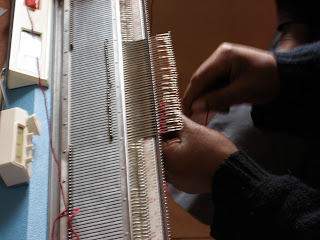 |
| photo by JG |
While Michelle shared some of the samples she'd brought of items that the women might produce for her to sell in California, the rest of us enjoyed mingling with the throng of onlookers. Marie snapped pictures of the mamitas who seemed at first apprehensive of having a camera in their face but soon warmed up when she showed them their portrait on her digital screen. They began to laugh so hard at the novelty of their own image that many of the pictures didn't turn out. This made them laugh even harder at their own closed eyes and silly expressions that had been frozen in each image. They had great fun and Marie promised to send them the best of the portraits through Percy.
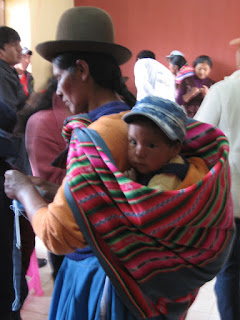 |
| Chitapampa knitter and child. photo by JG |
A while later, we were called into the community meeting room next to the factory. We were directed to sit on a bench at a table that had been spread with colorful fabric and platters of roasted corn kernels and slices of homemade cheese. Almost the entire community had gathered there and sat on wooden chairs and benches facing us. The way it had been all set up made it clear that we were guests of honor. Speeches were made; by Percy, by the village leader and by the woman who is "president" of the knitters. All expressed their profound gratitude to Rosa for having given them such hope through this opportunity for a sustainable source of income and for the support this new factory will provide within their community and families. Rosa shared her own words of excitement and thanksgiving and then we were each presented with a red rose in a bundle of white flowers that had been handpicked somewhere in the vicinity this morning. We accepted their offerings of homegrown corn and fresh cheese (though the cheese we nibbled gingerly--just enough to show our enthusiasm and gratitude--since Rosa warned us through a discreet game of "telephone" down the the line of us that last year people got sick from it . . . but what do you do when the whole village is sitting there watching you?)
 |
| Chitapampa community. photo by JG |
 |
| Happenings in the community room. photo by JG |
Finally we all spilled outside and the suitcases were untied from the roof of our bus. We handed out clothing and toys and this time I actively participated. It felt much more comfortable because there was so much more interaction and exchange with the people here in Chitipampa than in the communities we visited yesterday. It also made a huge difference that our group was so much smaller this time. It was fun to pull pieces of clothing out of the suitcases and try to match them to the appropriate recipient based on size, gender or age. A group of teenage girls in the corner were delighted with their new stylish tops. Young men smiled to receive soccer jerseys and pants. Mamitas eagerly accepted sweaters and warm layers. Children and infants were matched by size to some cute outfits with a little extra space for growing.
 |
| Passing out clothing and toys in Chitapampa. photo by JG |
When most all of our donations had been passed around, when everyone had received something (even our bus driver picked out a Superman toy for his young son in Cusco) and when we noticed people beginning to hide items they had already been given then hold their empty hands out again for more, it was time to go. As we bumped down the rutted dirt lane through the village and made our way back to the highway we waved goodbye with our bunches of flowers and smiled when we passed children down the road who were already playing with the toys we had just given them. I praise and appreciate Rosa for starting and supporting this simple textile project. It empowers the villagers (especially the women) with an occupation that they can maintain. Projects such as this are the kind that effect true and lasting change by their positive impact on development and on improving the lives of people that would otherwise not have such opportunity.
 |
| Arriving at Llaquepata. photo by JG |
On our way to the next village, Percy told Rosa that there would be a surprise. Again we left the main thoroughway and bumped onto an unpaved track that climbed and switchbacked steeply upwards through tended fields of various crops, meandering herds of sheep, scattered adobe homes and silvery-leaved eucalyptus groves (originally brought from Australia because it grows so quickly and is therefore a ready source of fuel . . . by now it has spread extensively throughout the mountains here). When we arrived in Llantaypampa we saw the women of the village waiting in a broad open field. I immediately saw that they had dressed in their finest clothing: traditional costumes worn only on very special occasions. The bright red color of their embroidered jackets and inverted cup-like hats stood out against the panoramic backdrop of the Andes. Their black woolen skirts and white ruffled blouses contrasted with the green agricultural terraces that traced the surrounding slopes of the Inca's Sacred Valley. They had constructed a simple archway of green branches for us to walk under and enter the open space where they stood waiting to greet us.
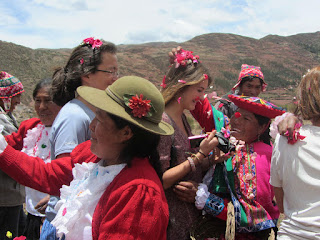 |
| Special greeting. photo by Marie Hasnain |
As we approached, two old men--one on a drum, the other on a flute fashioned out of PVC piping--struck up a lively song to accompany the warm-hearted welcomes of the women. They showered us with rose petals and kissed our cheeks with kind eyes and sweet words: "welcome to our village, welcome to our home." They clasped us each by the hand and led us into the field, stepping and dancing and pulling us to do so too. I looked into the wholesome face of the woman whose hand I held. She was a slightly older woman with the first traces of gray in her hair and a round sweet face. She beamed the most beautiful smile as she removed her hat and placed it on my head. We danced our way across the field, laughing at the unexpectedness of it all.
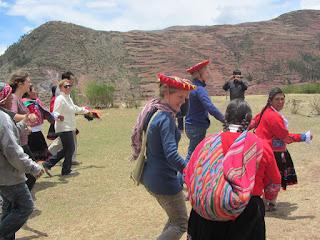 |
| Dancing across the field. photo by Rosa Ten |
|
|
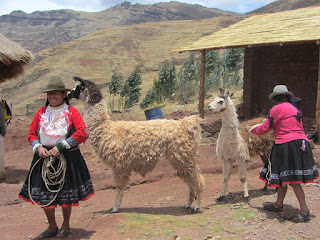 |
| Mamitas of Llaquepata. photo by Marie Hasnain |
 |
| Teresa in her new outfit. photo by Claudia Paya |
The women led us to a new structure that the whole village has been working on for some time . . . a spacious one-room adobe building with thatched roofing. They drew us inside and proudly gave us visual orientation as Percy explained: the village of Llaquepata decided to start a community-based ecotourism project. Within this building they plan to exhibit information about llamas and alpacas, about their history, their care, the steps involved in harvesting and processing their wool, demonstrations of how to spin and dye it, hands-on displays of the natural dyes they use to color the wool (different plants and wild herbs that grow around the village, seeds and soils/clay, insects, flowers and blossoms . . . a whole incredible range of beautiful earthy tones) and finally how they weave and knit the wool into beautiful handmade crafts. This is an art and skill that the people here have been practicing for countless generations. At the end of all this they had a small display of the items they will be producing to sell. Imagine us: a group of seven inspired women, so impressed by the project and by the beauty of their art, excited to be able to support them so directly . . . as the first group of visitors/customers, we gave them quite a day of business! Teresa even bought the hat that had been placed on her head when we danced in and then in a moment of inspiration asked one of the mamitas if there was perhaps one of their woolen skirts to buy . . . after one almost imperceptible moment of hesitation, the mamita giggled, took off her skirt, tied it around Teresa's waist and did a playful dance in her underskirts!
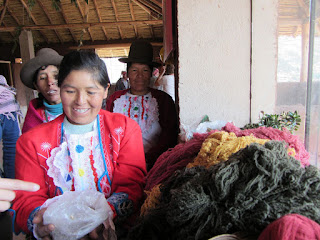 |
| Natural dyes. photo by Marie Hasnain |
The people of Llaquepata hope to complete the construction of their project and open to their first tour groups--that's where Percy comes in, who does all this as a volunteer--in about a month. I'm sure that if or as soon as they are able to make one we will all be spreading their brochure to everyone we know and to anyone headed to Peru. The project has so much potential in that it was started by/for the community itself and cooperatively developed by these people with the hope of supporting their families and sustaining their community (of less then 100 people) in this fairly remote area. The idea is great, the people are working hard to make it happen and location/scenery is enough to draw anyone out here. A large window balcony in their display room looks out onto the high surrounding mountains and the deep terraced valley down below.
 |
| The Sacred Valley. photo by Julia Gundling |
After we had made some purchases we were led outside to a small table that had been set up for us. Speeches were delivered. The leader of the community spoke for a while in Quechua, which was then translated to Spanish by Percy, which was then translated to English by Rosa for those in our group that don't speak Spanish. The community treated us like very special guests of honor. Colorful striped blankets had been placed on the curb of the building for us to sit on and as we settled beside each other in a row facing all the women who sat on the ground across the way from us, lids were lifted from the handmade clay crocks on the table to reveal savory potato pancakes, nutty roasted quinoa, stewed lima beans, onion-fava bean relish, baked chicken and roasted cuy (guinea pig--a traditional and classic specialty of Peru). All of the food had been cultivated right there in Llaquepata and had been thoughtfully prepared (all morning) in anticipation of our arrival. Percy explained that this meal (especially the cuy) is only made on very special occasions like weddings, baptisms and Christmas. I was touched beyond words, feeling deeply honored and humbled by their absolute generosity and open-hearted warmth. We were each served a heaping bowl of the food and it was one of those situations when one simply
cannot be picky. The villagers sat and watched as we ate. They did not partake themselves until we were nearly finished and then they had to take turns amongst each other because there weren't enough bowls and utensils to go around. I decided to risk the possibility of getting sick because their gesture was so deeply given. I managed to eat everything despite the involuntary gag reflex when I saw a few remaining hairs on the roasted skin of the guinea pig.
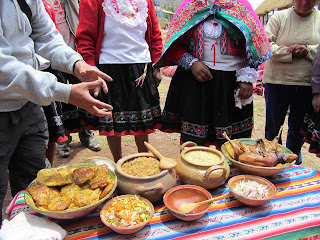 |
| A meal only for very special occasions. photo by Marie Hasnain |
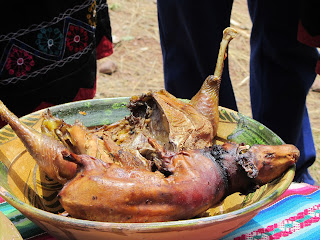 |
| mmmm . . . cuy! photo by Marie Hasnain |
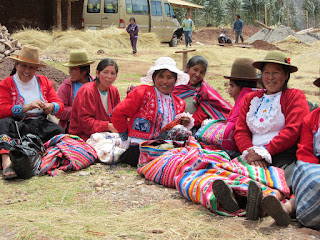 |
| Our audience during the meal. photo by Marie Hasnain |
 |
| photo by Claudia Paya |
As we returned to our bus, I walked arm in arm with one of the mamitas telling her how very grateful I am for all their generosity, how I will never forget how warm-hearted and "muy amable" everyone in her community is and how much love I feel for them. Just before we stepped onto the bus they gifted us each a handmade knitted scarf. The two musicians played another tune and we waved through the windows as we rolled away. Just up the road we passed a group of workers including several mamitas whose bowler hats had been replaced by bright yellow hardhats, moving stones for the foundation of another structure related to their textile exhibition. On our way out of the town we stopped at their community room and emptied the last of the suitcases of donations. There were only a couple of men to help us unload . . . the rest of the village would find it all later and go through it themselves. I felt so much better about this kind of giving than the mass distribution of the villages yesterday. It is much more my style to give anonymously, leaving something to be discovered later as a surprise . . .
 |
| Llaquepata. photo by Julia Gundling |
 |
| Handsome locals. photo by Julia Gundling |
On our return to Cusco we happened to pass a llama/alpaca trade show and got out of the bus to check it out. The Andean mountains are where these camelloid species originated, and they have a long important history in the culture here. They are raised for their quality wool, for their meat (alpaca steaks) and for transport of heavy loads. Their relationship with humans precedes Inca times and they continue to hold an important place in the economy, religion and society of Andean peoples. We were the only non-Peruvians at the event and it was a rather mellow affair . . . a few stands with sweaters and other woolen goods, some llamas and alpacas standing in small enclosures, a small show-ring with bleachers and maybe about 100 people scattered throughout. Rosa, Claudia and I sat in the bleachers to watch the show for a few minutes. I was curious as to how the animals were being judged. The announcer mentioned the "fine ears and facial features" of one alpaca, the legs of another and of course the quality, color and fineness of their wool. The alpacas were rather strange looking, notably smaller and more petite than llamas with wool so thick it looked as if it had been skillfully molded like a sculpted hedgerow. One alpaca was awarded third place simply for having travelled the farthest. I visited with the llamas in their pens and was in heaven taking numerous comedic portraits. They are such hilarious creatures! Many of them had cleft palates that clearly displayed their lower teeth giving them an especially dorky appearance.
 |
| Andean rastas. photo by Julia Gundling |











